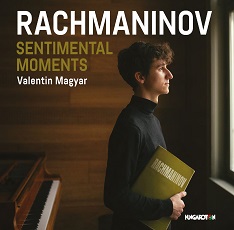Wenn Valentin Magyar Klavier spielt, erklingt Musik, die etwas zu sagen hat. Er sitzt am Klavier wie ein Poet und erzählt Geschichten. Er lässt sie aufblühen und schmückt sie mit einer wirklich stupenden Virtuosität aus. Einfach atemberaubend ist, welche Fülle an Noten dabei zu Gehör kommt, welche dynamischen Kontraste er produzieren kann.
Magyar kann auch die Energie mit Sensibilität verbinden. Gleich in den beiden ersten Stücken des Albums, in Rachmaninovs Etudes-tableaux op. 39,6 und op. 33,5 kann man diese aufregende Gegenüberstellung von grollender und explosiver Bravour sowie beseelter Ruhe erleben.
Magyars vibrierendes Temperament belebt Ausdruck und Aufbau im Großen wie im Kleinen, im Prélude op. 23,5 wie im op. 32,6.
Nicht weniger zwingend ist die Elegie aus den Cinq morceaux de fantaisie, in zarter Eindringlichkeit gespielt, und die Klangphantasie in den anderen Etudes-tableaux und Präludien ist genau so hinreißend wie die spontane Inspiriertet, mit der er Liebesleid spielt, welches das Programm dieses Albums beendet, dessen Zusammenstellung an sich schon von einem fein überlegenden Interpreten zeugt.
When Valentin Magyar plays the piano, he plays music that has something to say. He sits at the piano like a poet and tells stories. He lets them blossom and embellishes them with truly stupendous virtuosity. The wealth of notes he can produce and the dynamic contrasts are simply breathtaking.
Magyar can also combine energy with sensitivity. In the very first two pieces on the album, Rachmaninov’s Etudes-tableaux op. 39.6 and op. 33,5, one can experience this exciting juxtaposition of rumbling and explosive bravura and soulful calm.
Magyar’s vibrant temperament enlivens expression and structure on both large and small scales, in the Prelude op. 23,5 as well as in op. 32,6
No less compelling is the Elegy from the Cinq morceaux de fantaisie, played with delicate intensity, and the sonic fantasy in the other Etudes-tableaux and Preludes is as enchanting as the spontaneous inspiration with which characterizes Liebesleid, the final piece of the program, whose very composition speaks of a finely considerate interpreter.




















